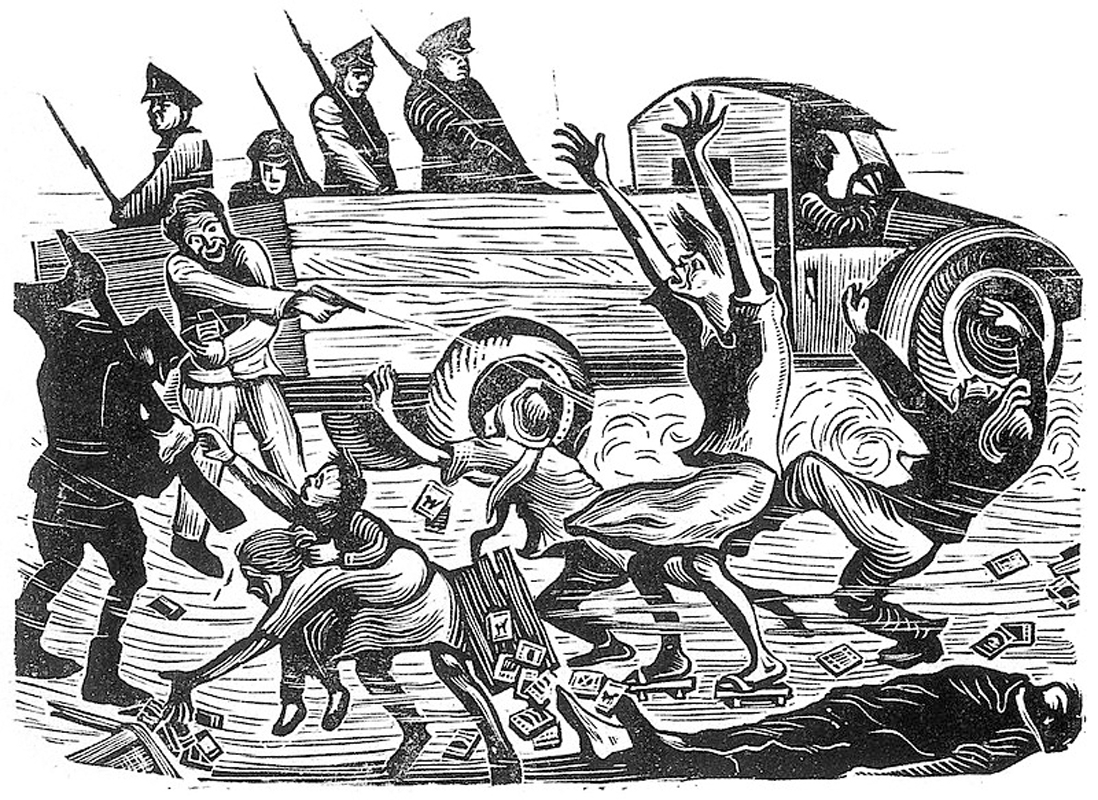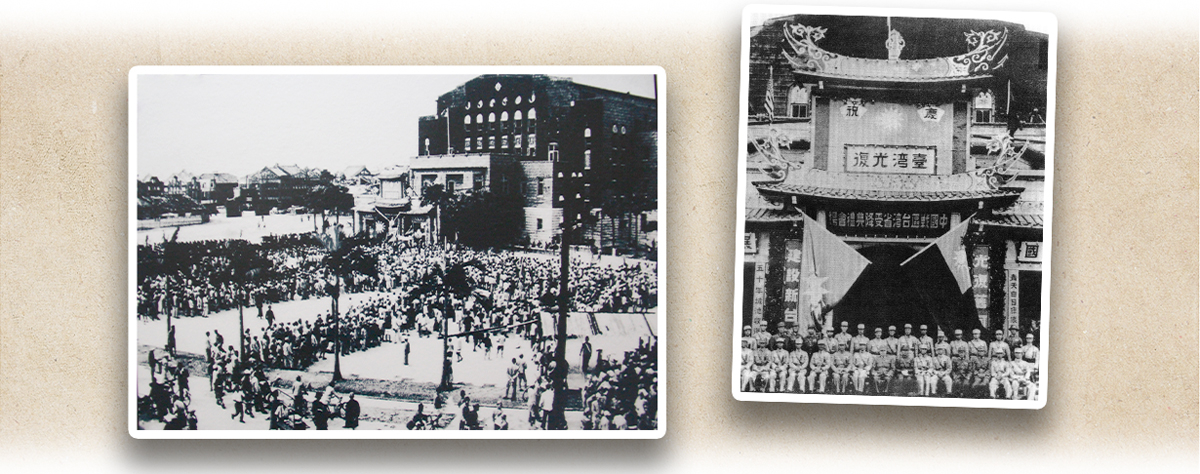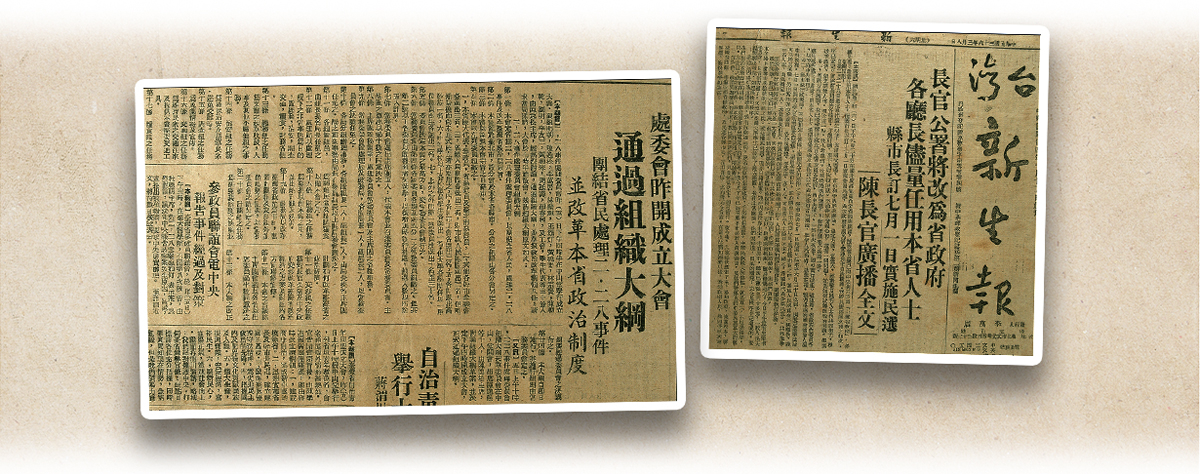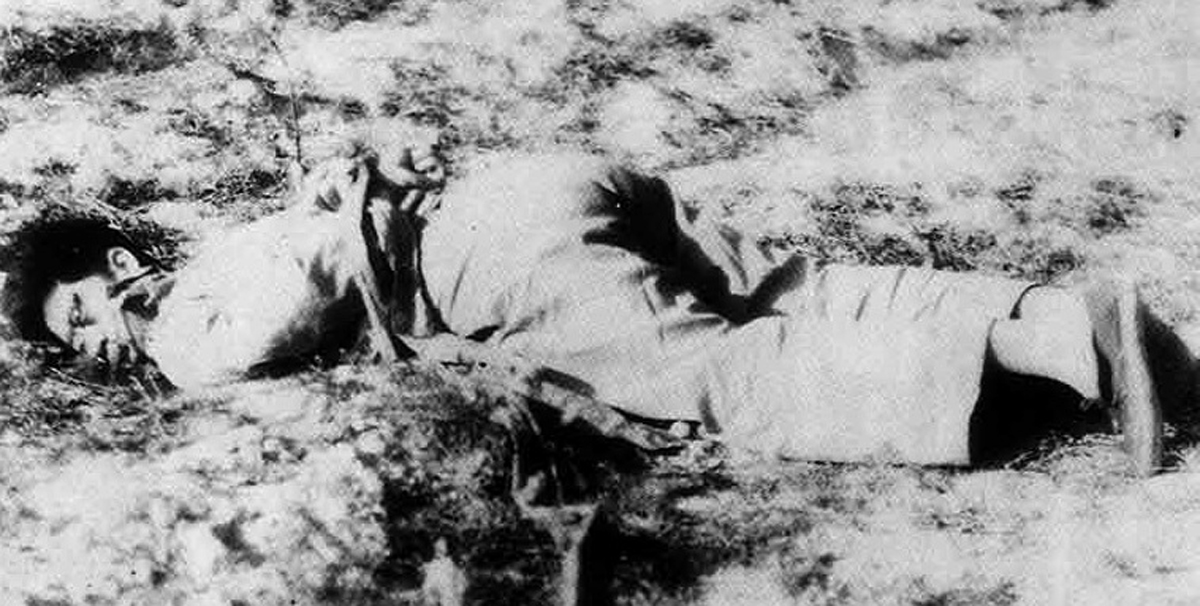After Japan surrendered, the Nationalist Government set up Taiwan Provincial Administrative Executive Office (台灣省行政長官公署) on 1 September 1945. On 25 October, Taipei (台北) witnessed the surrender ceremony and the inauguration of the Taiwan Provincial Administrative Executive Office as the province’s highest executive branch. Chen Yi (陳儀) was the first Chief Executive of Taiwan. The Taiwan Provincial Administrative Executive Office, the National Bureau of Investigation and Statistics (NBIS), the Central Bureau of Investigation and Statistics (CBIS), Three Principles of the People Youth League, and particularly National Resources Commission took part in the plunder of the entire island by shipping innumerable goods, especially commodities like rice, sugar, salt, and coal, to Mainland China, with the remainder pocketed by local officials and their subordinates. Out of insatiable greed, the ruling authority enforced the policy of “food allocation according to the number of household members” by force, imposed grain levies across Taiwan, reputed as a “rice granary”, and monopolised a selection of daily necessities. These unreasonable measures dragged the Taiwanese people into deep distress, exacerbating further by high inflation and massive unemployment. The situation was best illustrated by a Taiwanese song going like this, “I'd never expected that I would jump out of the frying pan into the fire.”
On 27 February 1947, Taipei Monopoly Bureau (台北專賣局) officials were chased by a crowd enraged by the physical attack on a cigarette vendor during an investigation into illegal cigarettes (the government had a monopoly on the sales of cigarettes). The Bureau officials opened fire on the crowd, killing one person. The following day, a large crowd stormed the Taipei Monopoly Bureau office and protested outside the Taiwan Provincial Administrative Executive Office. They were showered with gunshots by the guards, sparking island-wide demonstrations known in history as the February 28th Event, the February 28th Incident, or the February 28th Massacre. Conflicts between the military and civilians erupted all over Taiwan. In Taichung (台中), Hsieh Hsueh-hung (謝雪紅) and her associates organised a “27 Brigade” to put up armed resistance. In response, the Nationalist Government dispatched troops from Mainland China to suppress the opponents and initiated purging in Taiwan. It was not until mid-May that the unrest eventually subsided. According to a report issued by the February 28th Incident investigation team of the Executive Yuan (行政院) in 1992, 18,000 to 28,000 people were killed before and after the incident, with other studies putting the death toll at over 30,000.
|
|
What was done after the February 28th Incident and how was the process of vindication? |
|
|
See answer below. |
Right: the Japanese surrender ceremony held in the Zhongshan Hall (中山堂) of Taipei on 25 October 1945, marking the end of Japan’s 50-year rule on the island. Left: a scene outside the Zhongshan Hall and the ceremony in progress.
Left: on 21 March 1946, The Washington Daily News carried a report on Taiwan entitled “Chinese Exploit Formosa Worse than Japs Did”. Right: a question was raised by the provincial senator Lin Rigao (林日高) to Zhou Yi’e (周一鶚), the Head of the Civil Affairs Office, “Is Taiwan indeed our own land or a colony?”, which was published on The Taiwan Minpao (《台灣民報》) on 6 May 1946.
As Taiwan was returned to China after the victory of the War of Resistance Against Japanese Aggression, the military and government officials dispatched to Taiwan were accused of ransacking the island like what they had done in Mainland China. Consequently, the islanders suffered enormous hardship, fraught with problems of rampant bribery and corruption, runaway inflation, high unemployment, and food shortage. Officials from Mainland China also monopolised political power and saw themselves as rulers, making the islanders feel discriminated against and fuelling their grievances day after day.
On 27 February 1947, the beating of cigarette vendor Lin Chiang-mai (林江邁) sowed the seeds to the February 28th Incident. Left: Lin. Middle: Lin selling cigarettes. Right: The testimony made by Lin to the Taipei Monopoly Bureau after the incident. It says that she was hit on the head by someone from the Bureau with the hand grip of a pistol.
The officials of the Nationalist Government set up a monopoly branch in Taiwan to control the trading of essential goods and punish those people selling such goods without authorisation. The Monopoly Bureau staff reaped exorbitant profits through holding a monopoly coupled with uncivilised enforcement of law, stimulating the wrath and hatred of local Taiwanese. The incident could be traced back to 27 February 1947 when a number of Monopoly Bureau officers beat Lin Chiang-mai while attempting to take away her illegal cigarettes. They also shot a bystander dead. The incident eventually sparked a wave of mass protests.
On the morning of 28 February 1947, an outraged crowd stormed the Taipei Monopoly Bureau office and beat up its employees, killing two and injuring four others. They destroyed office furniture and glassware and set fire on the cigarettes, alcohol, matches, and cars in the office. Left: A crowd storming the Taipei Monopoly Bureau office. Right: a Bureau’s car was torched.
At noon on 28 February 1947, people gathering in front of the Taipei Railway Station for a peaceful petition to the Taiwan Provincial Administrative Executive Office, but were repressed by the government.
On the day of the petition, the masses marched to the intersection of Zhongshan Road. Just as they were about to enter the square, the guards in the office building immediately opened fire, causing many casualties. Arbitrary shooting fuelled the flames and a wave of protests soon swept across Taiwan. In some places, local Taiwanese formed their own armed groups to fight against the National Revolutionary Army (NRA).
Two local reports on the February 28th Incident. Left: A handling committee comprised mainly of elites of Taiwanese origin for the incident was set up on 5 March 1947. A memorandum of association was passed in the hope of engaging a dialogue with the government to resolve the crisis. Right: Chief Executive Chen Yi publicly committed on 6 March 1947 to implement political and democratic reforms, with a democratic election of county heads and city mayors. However, despite his gesture of goodwill, he also urged Chiang Kai-shek (蔣介石) in secrecy to throw more troops into suppression.
Facing a worsening situation and due to a shortage of reinforcement troops for a full crackdown, Chen Yi reluctantly acted to placate the masses and accepted the handling committee’s proposal for a ban on the dispatch of reinforcements and carrying out political reforms. In fact, as early as 2 March, Chen had requested Chiang Kai-shek (蔣介石) in private to send more troops from Mainland China into suppression. Chiang accepted his suggestion and declared a state of mob insurgency on the suspicion that the Chinese Communist Party (CCP, 中國共產黨) might be behind it. More troops were thus sent to Taiwan. It coincided with the beginning of a full-scale civil war between the CCP and the Kuomintang of China (KMT, 中國國民黨). The CCP was waging a mass movement against the Nationalist Government nationwide.
During the February 28th Incident, Hsieh Hsueh-hung and her supporters organised the “27 Brigade” in Taichung to confront the NRA. With a CCP background, Hsieh was one of the founders of the communist party in Taiwan during the Japanese occupation. She did not officially become a CCP member until 1948, despite her claim to have joined the CCP in 1925. No matter how one sees it, the incident was mainly attributable not to the CCP’s incitement, but to the governance problems of the Nationalist Government officials in Taiwan. Even if some communists had been involved, the CCP would not have played a meaningful planning or leadership role in the mass protests. Hsieh fled to Mainland China following her defeat by the NRA. In 1957, she was branded as a “rightist” and expelled from the CCP. She was then publicly criticised and denounced many times for over ten years before she was persecuted to death in 1970 during the Cultural Revolution.
When reinforcement troops arrived, the Taiwanese Government led by Chen Yi intensified the suppression, causing heavy civilian casualties. This woodcut print The Horrifying Inspection by printmaker Huang Rong-can (黃榮燦) in April 1947 reflecting the arbitrary shooting and massacre of passers-by by the NRA.
Apart from the armed suppression, Chen Yi published a Letter to the People of Taiwan Province from Chief Executive cum Commander-in-Chief Chen Yi for Implementation of Blockage and Purging on 26 March 1947, with measures to check on residents, hunt down suspicious persons, and encourage informants. A large number of participants in the mass campaign, together with suspects and innocents, were arrested and killed. The photo above shows a victim of the purging operation.
On 17 March 1947, Chiang Kai-shek sent a group headed by the Defence Minister Bai Chongxi (白崇禧, the third from the left in front row) to Taiwan to investigate and present a moderate policy to address matters following the incident. However, repressive actions such as arrest and execution continued. On 16 May, the central government replaced the Taiwan Provincial Administrative Executive Office with Taiwan Provincial Government and substituted Wei Tao-ming (魏道明) for Chen Yi as Provincial Chairman. The chaos was gradually put to rest. The February 28th Incident went down in history as an event leaving eternal sorrow for local Taiwanese and profound implications for Taiwan’s political future.
On 18 June 1950, Chen Yi, the first Chief Executive of Taiwan and the official primarily responsible for the February 28th Incident, was accused of intending to defect to the CCP and instigating other KMT members to do the same. He was executed by shooting in Taiwan. The above photos show Chen being escorted to the execution ground and his dead body.
In January 1949, when the Nationalist Government was suffering heavy defeats in the civil war, Tang Enbo (湯恩伯), the Commander of the Nanjing-Shanghai-Hangzhou Garrison Command (京滬杭警備司令), reported Chen Yi to Chiang Kai-shek, saying that Chen was planning to defect to the CCP and persuading him to change sides. Chiang then ordered the arrest and surrender of Chen to Taiwan. On 19 May 1950, Chiang instructed the Taiwan military court to sentence Chen to death, with a handwritten note saying “execution by shooting”. On 18 June 1950, Chen was executed by shooting. As observed by some commentators, Chen was killed when the KMT was facing a most chaotic time following its retreat to Taiwan. Chiang ordered the killing for two reasons: to warn prospective defectors and to win local Taiwanese support in order to secure a footing in Taiwan.
Tang was a famous general in the War of Resistance, chalking up glorious victories in Tai’erzhuang (台兒莊) and other battlefields. However, when directing military affairs in Henan Province (河南), he was accused of corrupting military discipline and not being hard enough to resist the enemy. As a result, he was reproached for the fall of Henan to the Japanese troops in 1944 during the Battle of Henan-Hunan-Guangxi (豫湘桂戰役). He was later honoured for his successful counter-offensives in Guangxi Province (廣西). Tang found himself an unworthy man in his early years before he received support from Chen Yi who funded his studies in a military school in Japan. After returning to China, Tang was recommended by Chen for a military appointment and moved his way up rapidly in the military. Tang’s second wife was Chen’s adopted daughter. Tang was rebuked for his low moral character after he reported his benefactor and father-in-law Chen to Chiang, leading to the death of Chen. His wife and children left him, and because of his bad reputation, he was no longer trusted by Chiang after the Nationalist Government moved to Taiwan. In 1954, Tang died in Japan after suffering from a bad reputation, a family breakup, and a declining career.
|
|
What was done after the February 28th Incident and how was the process of vindication? |
|
|
The February 28th Incident and the all-out KMT-CCP civil war resulted in the long-term military control of Taiwan by the KMT authority. As early as on 17 March 1947, Chiang Kai-shek sent a 14-strong delegation including the then Defence Minister Bai Chongxi to Taiwan for investigation and pacification to local Taiwanese. Information was also delivered that the principles of leniency, respect for law and discipline, restoring order, and promoting reforms would be implemented. On 11 May, Chen Yi resigned and returned to Mainland China. On 15 May, Wei Tao-ming, the new Chairman of the Taiwan Provincial Government, arrived in Taiwan and announced on the following day the lifting of martial law in Taipei and Keelung (基隆). The island-wide blockage and purging operations finally ended. During the period when Chiang Kai-shek and Chiang Ching-kuo (蔣經國) were in power in Taiwan, the February 28th Incident remained a political taboo unmentionable by the Taiwanese. In 1995, the government officially made apologies for the incident. On 23 March of the same year, the Legislative Yuan (立法院) enacted The February 28 Incident Disposition and Compensation Act, which was announced on 7 April for implementation to compensate the victims and their families of the incident. In 1997, on its 50th anniversary, the February 28th Incident was officially vindicated. In 2010, the government apologised for the incident again. |
Source of most photos used in this feature piece: Fotoe (pictures 1-4), misc. photo sources.
















